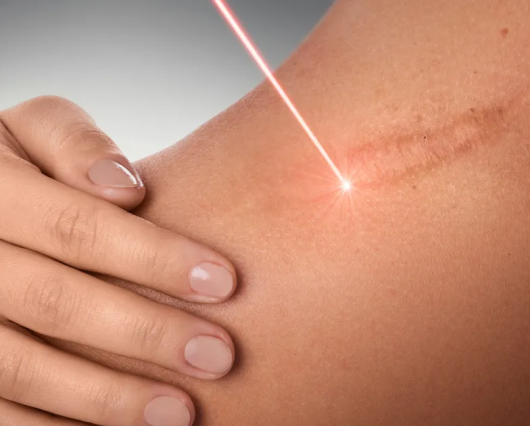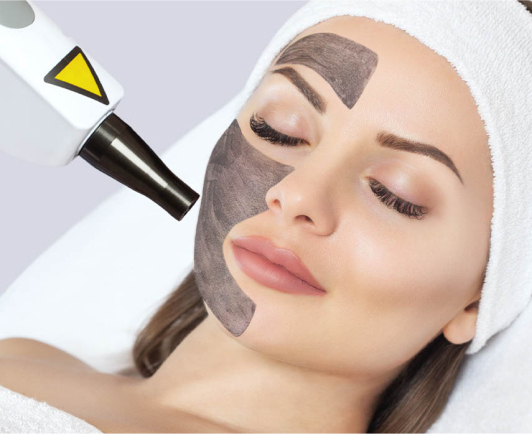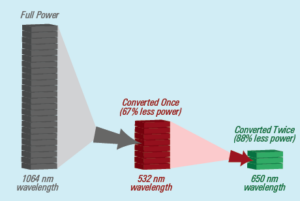How does the laser remove tattoos and how many sessions are needed?
Tattoos are basically ink particles injected into the skin, too big to be flushed out by our immune system even though they are recognised as foreign body. Lasers use ultra-short pulses to break the tattoo pigment into smaller fragments, which enables the lymph to eject them as a waste product.
You can’t expect a tattoo to be gone after a single laser session. Although the number of sessions required for complete tattoo removal greatly depends on tattoo type, location, colour, size, laser properties and operator’s skills, most patients generally need from 6 to 8 sessions with 6- or 8- week intervals in-between. It takes about 8 months to get rid of an unwanted tattoo.
What is the best equipment for tattoo removal?
Although the first laser tattoo removal happened far back in 1967 with a ruby laser, it was not earlier than the 1990s, when a really effective and safe technology became commercially available. Q-switched Nd:YAG lasers are powerful enough to break down tattoo pigment and by now are considered a golden standard for tattoo removal. These lasers emit the wavelength of 1064 nm which is ideal for black and dark tattoo inks. A special lense with 532 nm wavelength is most effective for removal of red and warm tone colours including violet, orange, yellow and brown. Other tattoo colours like sky blue or bright green and purple are dealt with additional dye handpieces (emitting 585 nm and 650 nm wavelengths).

What's the difference between pico- and nanolasers?

There are typically two large groups distinguished among the Nd:YAG laser family:
- Q-switched lasers generating wavelengths in nanosecond pulse range and
- lasers producing energy in picosecond range, also called picolasers.
The main difference between the two groups is their pulse length.
Shorter pulse length in picolasers accounts for a number of benefits:
Picolasers shatter the ink into much smaller particles than Q-switched nanolasers as too long pulse energy may target not only pigment but also spill over to the surrounding tissues causing bigger thermal damage. These smaller particles are more easily removed with a blood flow.
The same shorter pulse advantage leads to less painful treatment and faster recovery time thanks to minimal skin damage.
Due to shorter pulses both a single session and the whole treatment course time may be reduced.
Picolasers produce better tattoo clearance and work better with stubborn pigments that had not responded to nanolasers.
Does it mean that picolasers are your only option while choosing an equipment for your tattoo removal studio or beauty clinic? Not true. Q-switched Nd:YAG lasers have proven efficiency and received a lot of positive feedback, moreover, their functionality keeps up with that of picolasers.
In addition, when equipment price really matters, Q-switched lasers will be the optimal solution as an average price tag for picolasers is two or even three times higher than for nanolasers.
Which parameters should be considered while choosing a tattoo removal laser?
Pulse width
Here the rule applies: the shorter – the better. Our stand-alone Q-Switched Nd:YAG laser produces the pulse width of 6 or even 2 nanoseconds (depending on the model). When it comes to picosecond lasers, we can offer you two most advanced models of stand-alone picosecond lasers with the pulse width of 450 and 500 ps. If you’re short of space, opt for a portable version of Nd:Yag laser with 8 nanosecond pulse width. It does not have dye handpieces and may generate only the basic wavelengths of 1064 and 532 nm, still high energy fluence and two additional handpieces for fractional treatment and carbon peel comprehensively cover the treatment needs of various treatment projects. It is suitable for small beauty and tattoo removal studios which would like to start their business from scratch and update the necessary equipment with further budget and clientele growth.
Spot size
The larger the spot size, the shorter the tattoo removal process. Some treatment zones like cosmetic tattoos at eyelid lines, eyebrows or lip lines require smaller spot sizes, others like forearms or thighs are better and faster treated with larger laser rays. So adjustable spot size is the best fit.
The deepest ink is reached with large spot sizes such as 10 mm, the ink which is closer to the surface is targeted by smaller ones.
While choosing a laser, pay attention to the laser energy range for avoiding the situation when a big spot size has limited power. Better lasers allow increasing energy with the spot size growth.
All our lasers except a portable version have a zoomable spot from 2 to 10 mm and energy adjusted from 50 mJ to 1000 mJ. A portable version operates with an unchangeable 6 mm spot size. The laser impact area is adjusted by changing the distance from a laser tip to the treated surface.
Laser fluence
The higher the pulse energy, the better pigment destruction. Lower fluences are usually used during the fist sessions when the pigment is still dense, the following sessions and faded tattoos require higher pulse energies.
Our tattoo removal systems have highly variable laser fluencies from 50 to 1000 mJ for nanolasers and from 50 to 800/1500 mJ for picolasers to cover every treatment need.
Repetition rate
The number of pulses per a second. Again, the higher – the more efficient and rapid tattoo removal.
Standard pulse rate makes 10 Hz (10 pulses per second). All our lasers except for a portable one with 6 Hz pulse rate have the standard 10 Hz frequency.
Other treatments performed with tattoo removal lasers
Skin pigmentation removal
Selective pigment removal by lasers is becoming increasingly popular as benign pigmented lesions are often very responsible to laser treatment. In most cases a laser targets melanin which is present both in endogenous and exogenous pigments. The most efficient wavelength is usually determined by the depth of pigment distribution. Pigmented lesions at the epidermal layer are well treated by an alexandrite laser (755 nm), the deeper lesions require longer wavelengths like 1064 nm (Nd:YAG laser). Remember that the 1064 nm laser is also beneficial for darker skinned individuals.
Age and sun spots, coffee spots, Nevus of Ota, pigmented birthmarks, melasma is a non-exhaustive list of pigmented lesions that may be treated by an Nd:YAG laser with a supplemental 755 nm handpiece offered by our company. The laser has pre-set programs for individual pigmented lesion types. Carefully selected settings and treatment protocol allow to achieve good cosmetic results and avoid side effects like skin discoloration.


Laser facials Laser facials are extremely effective for boosting elastin, collagen and fibroblast production, get more vibrant and healthy skin colour, and improve oil control. With an optional fractional handpiece you will be able to offer your customers skin pore tightening, wrinkle removal, improving skin texture, acne scars removal treatments. Moreover, Nd:YAG lasers allow to perform a celebrities’ favourite carbon peel, a non-invasive and non-painful two-phase treatment promising smooter, plump, radiant and bright skin along with deep skin rejuvenation. The treatment is no-downtime and has fewer risks of hyper- or hypopigmentation.
Warranty, maintenance and consumables
Lasers for tattoo removal do not need any consumables. These are highly automated systems with intelligent software to control any system failure. The preset treatment programs with widely adjustable parameters make the lasers easy to use not only by business owners with many years’ experience under their belts but by rookie beauty entrepreneurs as well.
Moreover, you can benefit from free video instructions on how to use or troubleshoot and maintain the lasers available on request.
Powerful cooling system allows back-to-back session booking with no downtime for 12 hours.
High lifespan ensures long-term flawless operation. You may replace worn or broken parts free of charge under a two-year warranty (upon 1 year expiry the delivery costs are covered by a customer).
Every machine comes with protection glasses for a customer and a client, you may order extra glasses when needed.
FAQ
Are there any limitations for Q-switched Nd:YAG lasers?
Please note that some tattoo inks are more responsive to laser treatment than others. Especially it refers to green or sky blue tattoos, which may be a real headache for a tattoo removal laser operator.
Actually, Nd:YAG lasers naturally produce only two waves – 1064 nm and 532 nm (which is half as powerful). Other wavelengths are achieved by double conversion resulting in significant pulse power cutting. Dye handpieces may occur ineffective for treatment of tattoos with prevailing green or blue colours. Such tattoo removal may require a bigger number of sessions and the result will not be guaranteed.

Darker skin types with green or light-blue tattoos make the situation even worse as 585 nm and 650 nm wavelengths are easily absorbed by skin melanin, meaning that a significant proportion of the laser energy may target the skin pigment rather than the tattoo ink. At that the risk of developing post-inflammatory hyperpigmentation and poor tattoo removal results grows significantly.
Still, there are some tips to overcome the above issues:
- use scar and pigmentation control topicals before and after laser tattoo removal;
- use fractional laser pre-treatment;
- choose the most powerful lasers and carefully control the laser energy at time of a session;
- give preference to picolasers rather than to nanolasers as they better work with colour tattoos;
- use shockwave therapy after tattoo removal as it greatly improves the results.
Which is better - picolaser or nanolaser?
If you’re full of doubt about the choice between a Q-Switched Nd:YAG nanosecond laser and a picosecond laser, please pay attention to the following
Price of the equipment
Generally, picosecond lasers are very expensive, and though they for sure offer excellent and safe tattoo removal, in most cases your customers will probably find the clearance rate by a good Q-switched nanolaser comparable.
Treatment price
Obviously, a picolaser price is reflected in the cost of treatments which may be 4 or even 5 times higher than a nanosecond laser session cost. No doubt, a customer may expect to reduce the ink in the tattoo slightly quicker, for example, have 5 sessions instead of 6. Nevertheless, the total cost may end up being much more expensive as compared to a nanolaser treatment course.
Frankly speaking, none can guarantee that a tattoo will be cleared with a certain number of sessions with either of lasers. It is really very much up to your body and the immune system, as well as the tattoo size, colour and location. There is no one size fits all length for a tattoo removal course.
Therefore if your financial opportunities are not limited, a picolaser most probably will be the best choice, however please remember that a high-quality Q-switched Nd:YAG nanolaser may be as good as an expensive picosecond laser.
What is the average cost of tattoo removal?
A complete laser tattoo removal cost depends on the number of sessions needed and this accounts for a technology and a treatment protocol used.
The factors influencing the tattoo removal cost include:
- Tattoo age and ink
“Fresh” pigments take more sessions to break up. Older tattoos usually have less pigment and are easier to remove.High-quality ink is designed to last longer so it is harder to smash it. Poor-quality inks may be naturally flushed out by lymph and are destroyed more freely.In addition, people with a stronger immune system may experience faster tattoo fading after laser tattoo removal start.
- Tattoo colour and size
Darker tattoo colours tend to fade faster than lighter hues. Larger tattoos take more time.
- Tattoo location
Certain parts of our body have larger blood flow, therefore the destroyed piment will be excreted more efficiently. Hand, wrist, finger, foot, ankle, or toe tattoos are prone to very slow fading and require a higher number of treatments.The less accessible a treatment zone – the higher a tattoo removal cost.
- Operator’s skills
More experienced specialists usually work at higher rates.
The average price for tattoo removal varies from 70 EUR per a 1-3 cm treatment area to 340-350 EUR per 16-20 cm treatment area for Q-switched Nd:YAG lasers and from 110 EUR per a 1-3 cm treatment area to 480 EUR per 16-20 cm treatment area for picolasers. These prices are indicative and may vary both up and down.
You may alternatively charge a flat fee per treatment, which may start at 200 EUR.
Most clinics offer package discounts.

